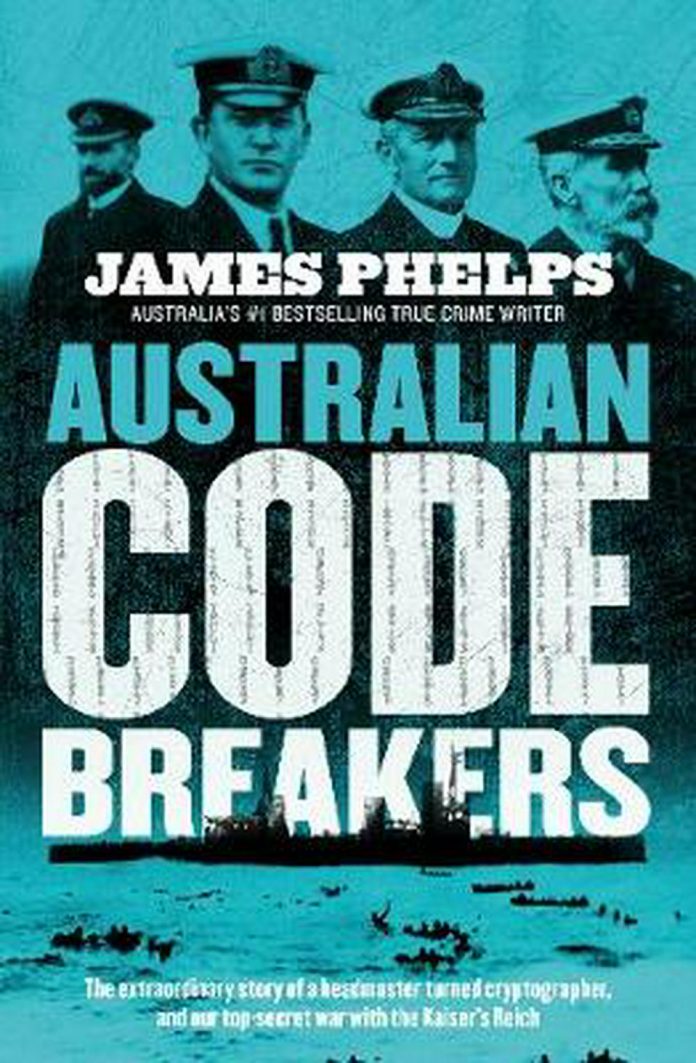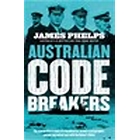

Australian Code Breakers. The extraordinary story of a headmaster turned cryptographer, and our top-secret war with the Kaiser’s Reich. By James Phelps. Harper Collins, Sydney, 2020.
Reviewed by Tim Coyle
BUY NOW FROM BOOKTOPIAThe cover of Australian Code Breakers depicts the book’s main characters, the chief of which is Naval Instructor Frederick Wheatley. With him appear Rear Admiral William Creswell, First Naval Member of the Australian Commonwealth Naval Board, George Patey, ‘Rear Admiral in the Royal Australian Navy to Command His Majesty’s Australian Fleet’ and Commander Walter Thring, nominally Creswell’s assistant but actually a gifted strategic thinker credited with preparing the RAN for war.
The author, James Phelps, is billed on the cover as ‘Australia’s #1 Bestselling True Crime Writer’ and the book is summarised as ‘a thrilling, fast-paced and thoroughly modern telling of one of Australia’s greatest military triumphs, written by our number-one true crime writer’.
The story covers the well-known, but always engaging and dramatic, seizing of the German Mercantile Code Book (Handelsverkehrbuch – HVB) at the outbreak of war in 1914 from the German ship Hobart in Port Phillip by Captain Richardson, the District Naval Officer, and the efforts of Frederick Wheatley to break the code. This was an early intelligence coup which stood the RAN in good stead with the Admiralty. However, subsequent Admiralty actions deprived Patey and his fleet unit the opportunity to engage the German East Asia Squadron which achieved victory in the Battle of Coronel but was itself destroyed at the Falkland Islands action.
Phelps’ bibliography shows his extensive use of primary sources in the National Archives of Australia (NAA) files pertaining to signals intelligence, ship movements and incidents associated with the period and his secondary sources include works by well-known naval historians. The Appendix provides reproduced original documents from the NAA files which add to the narrative.
However, the ‘thrilling, fast-paced and thoroughly modern telling’ is highly coloured and heavy with exaggeration. There is little or no regard paid to accuracies in naval protocol or the technology of the times. The book includes ‘modern’ interpretations of the battles at Coronel, the Falkland Islands and the Sydney-Emden action.
Wheatley’s HVB code breaking is a tale worth telling to today’s generation and the writing style might appeal to a younger generation readership. However, those not attracted to thrill-seeking from fast-paced and modern tellings might pass on this one.




I recently read this book and was thoroughly disappointed. I agree with all the critical points made by Tim Coyle. I only wish I had read this review prior to buying the book. Mr Phelps takes history-fiction beyond even Peter Fitzsimmons’ ‘Batavia’. Fictional meetings and dialogue between historic figures adds nothing to the story (a story worth telling). I was not expecting the tactical detail of a Tom Clancy or a Patrick O’Brien, but when the author mixes the use of battleships and destroyers or has both Patey and Von Spee issuing helm orders, it is like fingers down a blackboard. I am surprised that Tim Coyle did not pick up Mr Phelps most egregious sin. On page 288 of the book, in dealing with the aftermath of the Battle of the Falkland Island the author manufactures a war crime! He states that HMS Kent approached the survivors of SMS Nurnberg floating in the water and turned machine guns on them, massacring the survivors. He then infers that HM ships Cornwall and Glasgow did similar with the SMS Leipzig survivors. This is pure fiction. I cannot find any trace of this incident occurring as written. In fact the opposite. The RN ships’ companies tried valiantly to save the lives of their fellow mariners, despite them being the enemy. Only for bringing the Australian elements of this story to the wider Australian reading public, I give it 1.5 out of 5.